Based on this answer I came up with the following Swift code:
PolygonRegion.swift
import Foundation
import CoreLocation
struct PolygonRegion {
let verticies:[CLLocationCoordinate2D]
private var maxLat: CLLocationDegrees!
private var maxLon: CLLocationDegrees!
private var minLat: CLLocationDegrees!
private var minLon: CLLocationDegrees!
private var epsilon: CLLocationDegrees
var center: CLLocationCoordinate2D {
return CLLocationCoordinate2D(latitude: minLat+(maxLat-minLat)/2, longitude: minLon+(maxLon-minLon)/2)
}
var latSpan: CLLocationDegrees {
return abs(maxLat-minLat)
}
var lonSpan: CLLocationDegrees {
return abs(maxLon-minLon)
}
init(verticies: [CLLocationCoordinate2D], epsilon: CLLocationDegrees = 0.01) {
self.verticies = verticies
self.epsilon = epsilon
for point in self.verticies {
maxLat = maxLat != nil ? max(maxLat, point.latitude):point.latitude
maxLon = maxLon != nil ? max(maxLon, point.longitude):point.longitude
minLat = minLat != nil ? min(minLat, point.latitude):point.latitude
minLon = minLon != nil ? min(minLon, point.longitude):point.longitude
}
}
public func isPointInside(_ testPoint: CLLocationCoordinate2D) -> Bool {
guard isInsideBoundingBox(testPoint) else {
return false
}
var intersections = 0
let outsidePoint = CLLocationCoordinate2D(latitude: self.minLat - epsilon, longitude: testPoint.longitude)
let testRay = Ray(point1: outsidePoint, point2: testPoint)
for index in 0..<verticies.count {
let edge = Ray(point1: verticies[index], point2: verticies[(index+1)%verticies.count])
if intersectionType(testRay,edge) == .intersecting {
intersections += 1
}
}
if intersections % 2 == 0 {
return false
}
return true
}
private func isInsideBoundingBox(_ testPoint: CLLocationCoordinate2D) -> Bool {
return !( testPoint.latitude < minLat || testPoint.latitude > maxLat || testPoint.longitude < minLon || testPoint.longitude > maxLon )
}
// See https://stackoverflow.com/questions/217578/how-can-i-determine-whether-a-2d-point-is-within-a-polygon/218081?s=1|193.4130#218081
private func intersectionType(_ ray1: Ray, _ ray2: Ray) -> IntersectionType {
var d1,d2: Double
var a1,a2,b1,b2,c1,c2: Double
let v1x1 = ray1.point1.latitude
let v1y1 = ray1.point1.longitude
let v1x2 = ray1.point2.latitude
let v1y2 = ray1.point2.longitude
let v2x1 = ray2.point1.latitude
let v2y1 = ray2.point1.longitude
let v2x2 = ray2.point2.latitude
let v2y2 = ray2.point2.longitude
// Convert vector 1 to a line (line 1) of infinite length.
// We want the line in linear equation standard form: A*x + B*y + C = 0
// See: http://en.wikipedia.org/wiki/Linear_equation
a1 = v1y2 - v1y1
b1 = v1x1 - v1x2
c1 = (v1x2 * v1y1) - (v1x1 * v1y2)
// Every point (x,y), that solves the equation above, is on the line,
// every point that does not solve it, is not. The equation will have a
// positive result if it is on one side of the line and a negative one
// if is on the other side of it. We insert (x1,y1) and (x2,y2) of vector
// 2 into the equation above.
d1 = (a1 * v2x1) + (b1 * v2y1) + c1
d2 = (a1 * v2x2) + (b1 * v2y2) + c1
// If d1 and d2 both have the same sign, they are both on the same side
// of our line 1 and in that case no intersection is possible. Careful,
// 0 is a special case, that's why we don't test ">=" and "<=",
// but "<" and ">".
if (d1 > 0 && d2 > 0) || (d1 < 0 && d2 < 0) {
return .nonIntersecting
}
// The fact that vector 2 intersected the infinite line 1 above doesn't
// mean it also intersects the vector 1. Vector 1 is only a subset of that
// infinite line 1, so it may have intersected that line before the vector
// started or after it ended. To know for sure, we have to repeat the
// the same test the other way round. We start by calculating the
// infinite line 2 in linear equation standard form.
a2 = v2y2 - v2y1
b2 = v2x1 - v2x2
c2 = (v2x2 * v2y1) - (v2x1 * v2y2)
// Calculate d1 and d2 again, this time using points of vector 1.
d1 = (a2 * v1x1) + (b2 * v1y1) + c2
d2 = (a2 * v1x2) + (b2 * v1y2) + c2
// Again, if both have the same sign (and neither one is 0),
// no intersection is possible.
if (d1 > 0 && d2 > 0) || (d1 < 0 && d2 < 0) {
return .nonIntersecting
}
// If we get here, only two possibilities are left. Either the two
// vectors intersect in exactly one point or they are collinear, which
// means they intersect in any number of points from zero to infinite.
if (a1 * b2) - (a2 * b1) == 0.0 {
return .coLinear
}
// If they are not collinear, they must intersect in exactly one point.
return .intersecting
}
private struct Ray {
let point1: CLLocationCoordinate2D
let point2: CLLocationCoordinate2D
}
private enum IntersectionType {
case intersecting
case nonIntersecting
case coLinear
}
}
Then
let verticies = [CLLocationCoordinate2D(latitude: 28.3795930, longitude: -81.5433286),
CLLocationCoordinate2D(latitude:28.3797771,longitude: -81.5431891),
CLLocationCoordinate2D(latitude:28.3797098,longitude: -81.5430725),
CLLocationCoordinate2D(latitude:28.3796355,longitude: -81.5431288),
CLLocationCoordinate2D(latitude:28.3794715,longitude: -81.5428780),
CLLocationCoordinate2D(latitude:28.3793546,longitude: -81.5429665),
CLLocationCoordinate2D(latitude:28.3795859,longitude: -81.5433219)]
let region = PolygonRegion(verticies: verticies)
let outsideTestPoint = CLLocationCoordinate2D(latitude: 28.3796098, longitude: -81.5430753)
let insideTestPoint = CLLocationCoordinate2D(latitude: 28.3796098, longitude: -81.5431453)
print(region.isPointInside(insideTestPoint))
gives
true
print(region.isPointInside(outsideTestPoint))
gives
false
